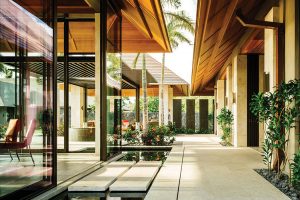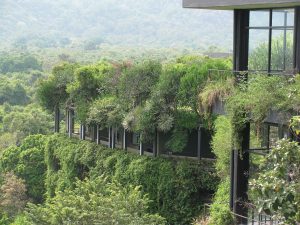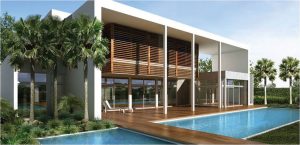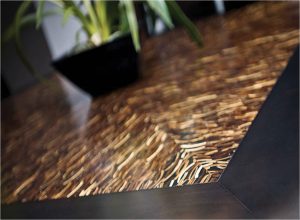In Pursuit of Modern Part 2
Tropical Modernism
By Shelagh Duncan
Last month we looked at the basic differences between Modern and Contemporary design, and now let’s explore the world of Tropical Modernism. That’s a little closer to home…

We saw that this movement was born out of the need to incorporate the Modern aesthetic into a tropical environment. Geoffrey Bawa was a leader in this field in Sri Lanka and understood that in a tropical climate the forces of nature are a thing to be reckoned with and you cannot build a beautiful structure and ignore its environment, so he began to incorporate them.
The architecture is composed in an intimate relationship with nature and is witnessed by his attention to landscape and vegetation, the crucial setting for his architecture. His sensitivity to the environment is reflected in his careful attention to the sequencing of space, the creation of vistas, courtyards, and walkways, the use of materials and treatment of details. 1
Not only that, he understood that when there is heat and humidity outside the buildings it was necessary to afford a level of comfort to its occupants as well as the structural beauty. In opening up the building to the outside he designed and positioned the structure to maximize the breezes, minimize the rain affect, and create necessary shade.

It was written of Bawa, “His architecture is seen as a line that defines and marks the presence of man in the landscape and then dissolves into the background to make way for life.” Using the topography of the site, local materials and skills, he managed to successfully achieve this.
Forty years earlier, another Tropical Modern movement had began to stir in Brazil. A Modern Arts festival in São Paulo in 1922 was probably the start of the Modernist movement there and in 1928 Russian architect Gregori Warchavchik built a modernist house for himself – which was the first in Brazil at that time – and used European practices together with local materials and methods to create this tour de force.
The following year Le Corbusier on his first visit to Rio de Janeiro gave some lectures to the elitist few who spoke French and could actually follow what he was talking about. Two of these were Lucio Costa and Oscar Niemeyer. They would later go on to define Brazilian Modernist architecture and design. They created the incredible Brazilian pavilion for the New York World’s fair in 1939, and set the US abuzz with excitement with this “erotic image of leisure, luxury and natural abundance that was hard to resist”2
An exhibit at the MOMA (Museum of Modern Art) followed and Niemeyer went on to design the high point of Brazilian Modernism – the planned city Brasilia in the 1950’s.
Brazil continues to be a leader in the Tropical Modernist movement and their furniture is widely regarded as some of the best. Beautiful tropical woods like jacaranda and tigerwood are used to their full advantage in showcasing Brazilian furniture.

Topical Modernism today embraces the principles of Modern design and adapts them from Urban environments to life in the tropics. It is now seen in many exotic places around the world. Drawing from its original inspirations and incorporating new ideas relevant to each location, this design style is growing in popularity because the clean lines, open space plan, and minimalist aesthetic perfectly fit our tropical lifestyles. It can be seen from Bali to Vietnam and from California to Hawaii, and each area has its own unique local interpretation.

Our design needs are specific to our area. Our climate is hot and humid most of the year and our sun is pretty powerful. The typical tropical modern house will not have large walls of windows – unless they are protected from direct sunlight. It will have large overhangs or shadings, and open interior spaces that allow great ventilation and air flow. Woods will be kiln-dried hardwoods, and the fabrics synthetic. Natural materials like bamboo and woven seagrass are not going to enjoy a long life here, so although the look is tropical, the imitation versions will work better unless you live with A/C. The overall style is still clean and minimalist and can incorporate ‘tropical’ details into the furniture.
Architects and designers are challenged with this style because we know that modern buildings rely heavily on glass and concrete. Glass allows strong sunlight to enter, creating heat and the possibility of fading furnishings. Concrete gets hot with the sun and radiates that heat for hours, so shade is a critical component. Exterior plantings and strategic overhangs need to be skillfully incorporated into the designs, as well as consideration for wind directions, rain protection and of course the use of suitable building materials.
Choosing an architect with local knowledge is critical when building a tropical home – modern or otherwise. For example a San Jose architect may be able to create wonderful living spaces in the Central Valley, but many do not understand our unique micro-climate here. You could end up with an amazing looking home – with poor airflow, moldy areas and blowing rain in your living spaces.
Tropical Modernism is another evolving style that borrows from Modern design principles, but works with local materials and conditions to create beautiful spaces. It is more popular now than ever and I think this style will continue to be desirable. If you are building be sure to do your research. Your home in the jungle is an investment for your future. Make good decisions and you will enjoy it for many years to come.
Until next time,
Royal Palm Interiors – around the corner from BCR in Uvita – 2743-8323
royalpalminteriors.com
Like us on Facebook: facebook.com/RoyalPalmInteriors
1Genius of the Place: The Buildings and Landscapes of Geoffrey Bawa by David Robson
2Brazil: Modern Architectures in History by Richard J. Williams
